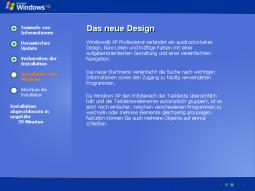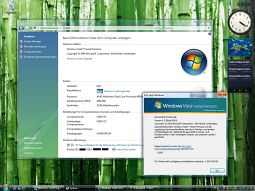 Windows XP The Windows eXPerience operating system is available as home and professional edition and are similar suitable for the use on standalone computers. The home edition is suitable for user which worked with Windows 9x/ME till now and don't need special network or security features in theire environment. If the user have used Windows NT/2000 private, in business or both, the Professional Edition is not only with a view of the administration optimally. Microsoft already encloses 10,000 drivers on the installation media of Windows XP, about the Windows update further more 2,000 drivers are available.
Windows XP The Windows eXPerience operating system is available as home and professional edition and are similar suitable for the use on standalone computers. The home edition is suitable for user which worked with Windows 9x/ME till now and don't need special network or security features in theire environment. If the user have used Windows NT/2000 private, in business or both, the Professional Edition is not only with a view of the administration optimally. Microsoft already encloses 10,000 drivers on the installation media of Windows XP, about the Windows update further more 2,000 drivers are available.The Professional Edition of Windows XP has more network features than the Home Edition. An update of Windows 9 x/ME is possible, with Windows NT/2000 only the Professional Edition can be used for update. Optional FAT32 and NTFS are available as a file system for the installation partition.
Windows XP (Windows version 5.1) becomes a predecessor of Windows 9x/ME as well as Windows NT/2000 and is available for 32-bits CPUs in the following versions:
- Embedded - Home Edition (1 CPU) for private user (Oct. 2001) - Professional Edition (2 CPU) for business user (Oct. 2001) - Media Center (1 CPU) especially for multimedia devices (Nov. 2002) - Tablet PC Edition especially for Tablet PCs (Nov. 2002) - Server Edition (4 CPU) - Advanced Server (8 CPU), also 64-bit Intel CPUs - Microsoft Windows Fundamentals for Legacy PCs (July 2007)
A 64-bit version of Windows XP was announced officially of Microsoft in April 2003. The RC2 was available in February 2005. Windows XP Professional x64 was published in April 2005. At most 16 gbyte RAM are utilizably with that, the virtual address range enlarges to 16 tbyte.
Same will be the product activation at all versions, which is needed at every new installation or extensive upgrade of the PC devices. Company customers can use an so-called Corporated version by a special licensing option without this product activation.
As the most visual innovation the revised Windows interface with the new design is well done, the design called Luna (as of beta 2428) can display window elements in high colour. The return to the interface as of Windows 2000 is further possible. The representation and organisation of the central registry is quit the same as used in Windows 2000.
1.2 Windows VISTA

Microsoft published the new product name Vista for this new Windows Version on an event in the USA/Atlanta on 21-07-2005. This Windows Version was known under the development name Longhorn before. The installation of Vista is based on WIM (Windows Imaging format), a file-based Image Format. It compresses the contained files and can be used for the installation on several platforms from the same Image. The image on the DVD contains a pre-installation of the system directories of Windows in the Windows Imaging (.WIM) file and adapts to the hardware configuration. With the User State Migration Toolkit the user defined settings can be imported of Windows 2000 and Windows XP. An advantage of WIM images is the easy integration of new drivers and updates, the LZX compression provides the smallest file size and XPress compression the fastest compression. The installation DVD of Windows Vista already contains about 16,000 drivers, the Windows update offers further 14,000 drivers for supported hardware. There is no licence key during the Windows Vista installation necessary, in this case it start with a 30 days trial license. After this time period the activation of the operating system is inevitably with the Internet Explorer, after the start-up Windows opens only this window for activation. Windows Vista contains DRM technology for the playback of protected multimedia files.
1.3 Windows 2000

Microsoft released this new Windows version 5.0, Build 2195 in February 2000. It is the desktop operating system of the new Windows 2000 platform for x86 architecture and be completed by the versions Windows 2000 Server, Windows 2000 Advanced Server and Windows 2000 Datacenter Server. As a minimum requierement for the installation a Pentium processor, 32 mbyte main memory and 650 mbyte of free hard disk storage are needed. Microsoft had planned to develop also a operating system version for the Alpha architecture, the plans were stopped after an announcement of Compaq. Compaq restricted the support to Windows NT 4.0 with service pack 6 and not higher at 1999-08-25. Microsoft stopped the development plans for the Windows 2000 32- bit of Alpha version after that. Windows 2000 unites defined roughly the user-friendliness, pug & play and USB device support of Windows 98 and the safety and stability of the Windows NT family. The update to this new operating system is possible from Windows 95, 98 and Windows NT 3.51, 4.0. It is a multitasking, multiprocessing operating system and supports up to 2 processors of the x86 32- bit and 64 bit architecture with SMP. Threads or processes can choose between the available processors. Beside the complete revision new features and many improvements are integrated. The result is high compatibility, simplified administration, increased hardware support with over 7,000 devices, file administration and extended security functions. Applications for Windows 9x are only supported restrictedly. The installation is possible from CD-ROM or over the network from a file server. The virtual addressable storage is 4 gbyte and is managed by the Virtual Memory manager (VMM). VMM assigns the addressable storage on the actually available physical memory and the memory page file (pagefile.sys) on hard disk.
1.4 Windows Linux

Red Hat Linux 9.0.93 beta, codenamed "Severn", was released today. Read more for a quick commentary and six screenshots of the release.Installation hasn't changed much, it is now more refined, and the last bit about configuring graphical/text mode booting and X configuration is now completely gone. Red Hat Linux beta has successfully probed my E-540 Sony 21" monitor and my Matrox card, but for safety reasons, defaulted it in 1024x768 res instead of 1600x1200@85Hz (monitor's recommended). All hardware is working correctly, it even found my USB Creative WebCam Pro for use with GnomeMeeting.
After you install the 3 CDs and you do the first booting, right after the kernel is loaded, you are greeted with a graphical booting procedure. It is plain, but it works... I have to note here that while Red Hat successfully told LILO to load an SMP kernel for my dual Celeron system, it would stop loading the OS right after initializing the swap. Reseting the machine and booting with the non-SMP kernel, worked fine.
There is a first-time wizard, where you can create new users, subscribe to Red Hat Network etc. After that, Gnome is loaded and it looks pretty much, exactly the same as in Red Hat Linux 9. There are of course some new packages, like Evolution 1.4.3, Mozilla 1.4, but a lot of other packages are still not updated, e.g. OOo, the core Gnome itself (2.2.0 the About box says), but they should be before the release.
There are updates on many preference panels, and a few news ones too. There is new panel for graphics display (and even a per-user resolution panel --no need to be root to change your res), an updated package manager panel, updated hardware list panel etc.
There are still a few bugs around, which is normal, as this is a beta. Most noteworthy are Mozilla's fonts which are now bolding on many web pages where it shouldn't (including osnews' and parts of slashdot's), the Theme Manager has a problem when displaying the little theme thumbnails when changing themes, notification area is completely buggered up on my fresh installation. I am sure these small problems will be fixed before the final version though.
I hope some packages will be added till then, like the Vera fonts (which exists on Rawhide, but not on Severn). Another addition I would like to see is BlueFish 1.0, Gnumeric 2.x and AbiWord 2.0. At least two of these packages should be releasing their final versions before the release of Severn itself in October.
Please note that the screenshots below are showing the Gnome desktop using the high quality Vera TTF fonts, which I installed afterwards. The default Red Hat installation is still using the Sans fonts as in its previous versions.
0 comments:
Post a Comment